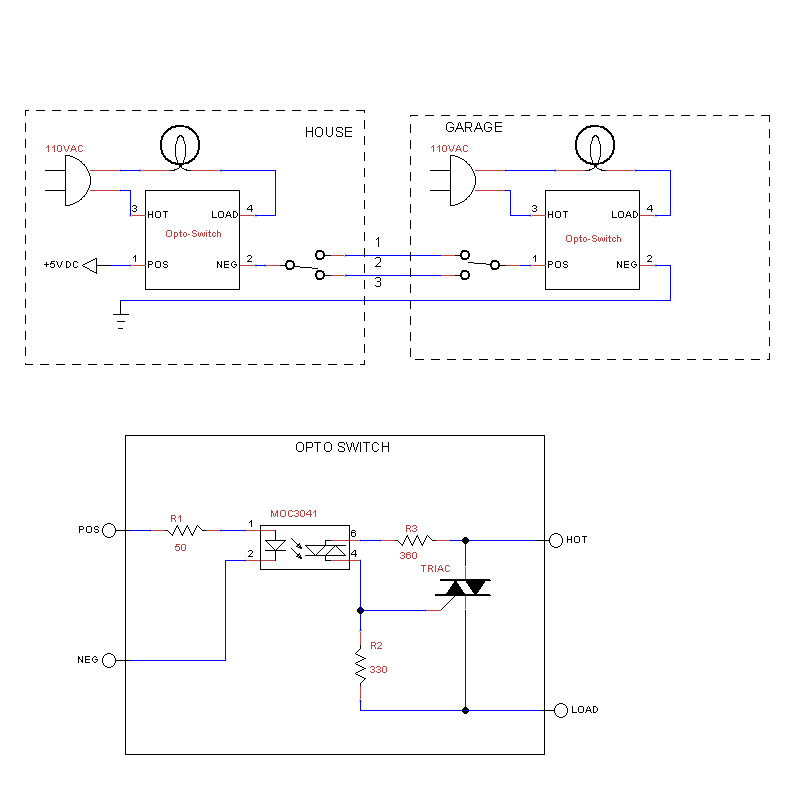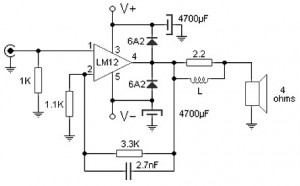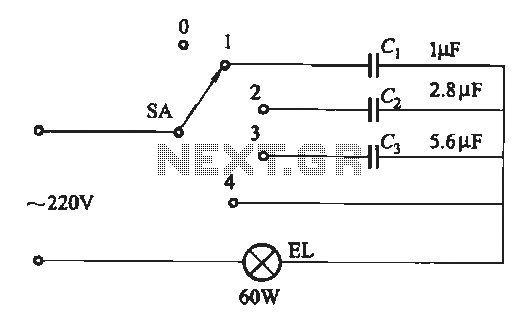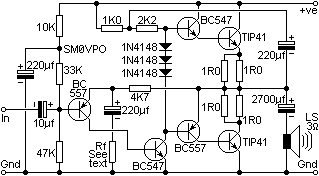
TV audio circuit TDA2009

The audio circuit, commonly utilized in color television sets, features the TDA2009 integrated circuit. The pin configuration is as follows: Pin 1 is designated for the left channel input at 1.2V, Pin 2 serves as the left channel feedback at 0.8V, Pin 3 is for Squelch at 12V, Pin 4 is for right channel feedback at 0.8V, Pin 5 is the right channel input at 1.2V, Pin 6 is connected to ground at 0V, Pin 7 is empty at 0V, Pin 8 provides the right channel output at 12.4V, Pin 9 is the power supply at 24V, and Pin 10 is the left channel output at 12.4V.
The TDA2009 is a popular audio amplifier IC used in various applications, particularly in color television sets. This device is designed to deliver high-quality audio output while maintaining low distortion levels. The pin configuration described allows for efficient signal processing and amplification of audio signals from both left and right channels.
Pin 1, with a voltage of 1.2V, receives the audio input for the left channel, which is then processed through the amplifier. Pin 2, at 0.8V, functions as the feedback loop for the left channel, ensuring stability and improved sound quality by allowing the amplifier to adjust its gain based on the output signal. Pin 3 is dedicated to Squelch, operating at 12V, which is typically used to mute the audio output during periods of silence or when no valid audio signal is detected.
For the right channel, Pin 4 also operates at 0.8V, providing feedback to enhance audio fidelity. Pin 5, similar to Pin 1, serves as the right channel input at 1.2V. The ground connection is established at Pin 6, which is crucial for the overall stability of the circuit. Pin 7 is left unconnected, indicating that it is not utilized in this specific configuration.
Pin 8 outputs the processed audio for the right channel at 12.4V, while Pin 10 provides the left channel output at the same voltage level, ensuring both channels deliver adequate power to the connected speakers or audio output devices. The power supply for the circuit is connected through Pin 9, which requires a stable 24V input to operate effectively.
Overall, the TDA2009 audio circuit is engineered to provide robust performance in television applications, with careful attention to feedback mechanisms and power management, ensuring high-quality audio reproduction. As shown in the audio circuit is commonly used in color television sets (TDA2009) Pin 1: 1.2V-- left channel input Pin 2: 0.8V-- left channel feedback Pin 3: 12V-- Squelch 4 fe et: 0.8V-- right channel feedback 5 feet: 1.2V-- right channel input 6 feet: 0V-- ground Pin 7: 0V-- empty 8 feet: 12.4V-- right channel output 9-pin: 24V-- Power 10 feet: 12.4V-- left channel output 11 feet: -
The TDA2009 is a popular audio amplifier IC used in various applications, particularly in color television sets. This device is designed to deliver high-quality audio output while maintaining low distortion levels. The pin configuration described allows for efficient signal processing and amplification of audio signals from both left and right channels.
Pin 1, with a voltage of 1.2V, receives the audio input for the left channel, which is then processed through the amplifier. Pin 2, at 0.8V, functions as the feedback loop for the left channel, ensuring stability and improved sound quality by allowing the amplifier to adjust its gain based on the output signal. Pin 3 is dedicated to Squelch, operating at 12V, which is typically used to mute the audio output during periods of silence or when no valid audio signal is detected.
For the right channel, Pin 4 also operates at 0.8V, providing feedback to enhance audio fidelity. Pin 5, similar to Pin 1, serves as the right channel input at 1.2V. The ground connection is established at Pin 6, which is crucial for the overall stability of the circuit. Pin 7 is left unconnected, indicating that it is not utilized in this specific configuration.
Pin 8 outputs the processed audio for the right channel at 12.4V, while Pin 10 provides the left channel output at the same voltage level, ensuring both channels deliver adequate power to the connected speakers or audio output devices. The power supply for the circuit is connected through Pin 9, which requires a stable 24V input to operate effectively.
Overall, the TDA2009 audio circuit is engineered to provide robust performance in television applications, with careful attention to feedback mechanisms and power management, ensuring high-quality audio reproduction. As shown in the audio circuit is commonly used in color television sets (TDA2009) Pin 1: 1.2V-- left channel input Pin 2: 0.8V-- left channel feedback Pin 3: 12V-- Squelch 4 fe et: 0.8V-- right channel feedback 5 feet: 1.2V-- right channel input 6 feet: 0V-- ground Pin 7: 0V-- empty 8 feet: 12.4V-- right channel output 9-pin: 24V-- Power 10 feet: 12.4V-- left channel output 11 feet: -





